Venison Tenderloin with Roasted Red Peppers
October 19, 2008 | Updated December 28, 2020
As an Amazon Associate I earn from qualifying purchases.
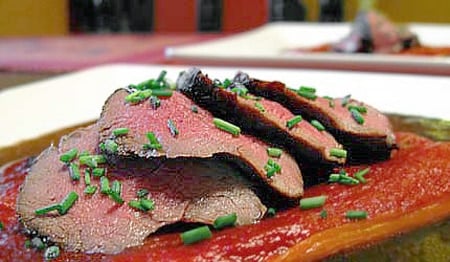
Tenderloins are morsels to be treasured. For those of you who don’t know, the tenderloin is a small strip of meat on the underside of an animal’s back; it does very little work, and as such is always meltingly tender. Thus the name. It is filet mignon.
It is also a cut that I rarely share with outsiders — sharing a delicate tenderloin with Holly is one of our minor intimacies. It’s not that I am greedy, it’s that the cut on a deer or antelope is so small that one will only really feed two comfortably. Large deer tenderloins can feed more, but we still find ourselves gobbling down a whole one between the two of us.
So I was surprised to find an antelope tenderloin in the freezer. I shot two antelope, a buck and a doe, in Wyoming last year, so I had acquired four little tenderloins. We ate one straight away. One of my little traditions after big game hunting is to cook one tenderloin rare with just salt and pepper for us when all the hard work of butchering and packing and sealing away is done. I always want to eat at least one cut that has never seen the freezer.
Venison Tenderloin with Roasted Red Peppers
Ingredients
- 1 venison tenderloin
- Salt and freshly ground black pepper
- 3 tablespoons butter
- 1/4 cup Port wine
- 1/2 cup venison broth or beef stock
- 1 whole, large fire-roasted red peppers
- 2 tablespoons dried morel mushrooms
- Chives for garnish
Instructions
- Take the tenderloin from the fridge and salt it well. Set it aside to come to room temperature for about 20 minutes.
- Lay out the roasted red pepper and cut it into large squares (circles would be fine, too). Remove any stray seeds.
- Grind the dried mushrooms to a powder in a spice grinder, the add to the venison stock.
- Heat 2 tablespoons butter in a saute pan over medium-high heat. When it stops frothing, saute the tenderloin about 3-5 minutes per side, depending on how you like your meat. Set aside under foil when done.
- To make the sauce, deglaze the pan with the Port. Scrape up any brown bits with a wooden spoon. When the Port is reduced to a little more than a glaze, add the venison stock and bring to a boil. Reduce this to the point where when you run a spoon through it, the sauce takes a moment to close the trail you left in the pan with the spoon. Turn off the heat and add the final tablespoon of butter. Swirl to combine.
- To serve, pour some sauce down on a plate, then top with the red peppers. Slice the tenderloin and arrange it on the red pepper. Garnish with chopped chives.
Nutrition
Nutrition information is automatically calculated, so should only be used as an approximation.
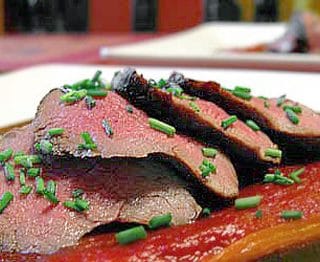
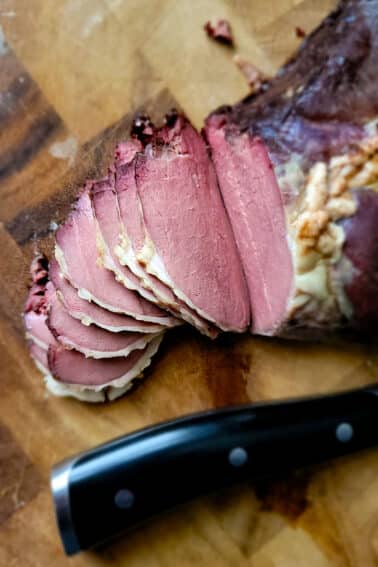
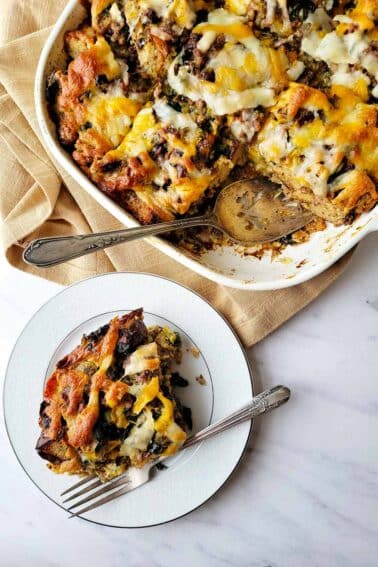
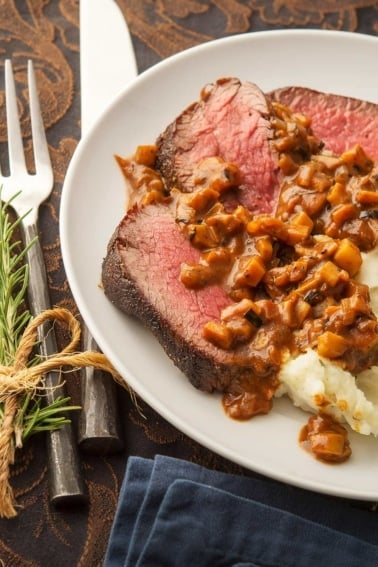
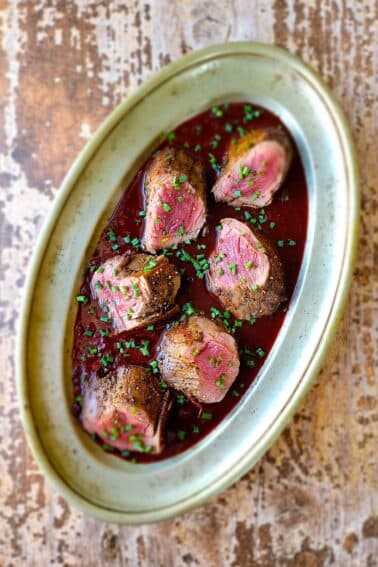
amazingly good. thanks so much.
Hank you are the goddamn man.
Nilgai are from India. However, males are technically called ‘nilgou’. I live twenty minutes from the best nilgai hunting in the state. In Texas, nilgai is so ingrained into the common venacular to mean males and females, it’s pointless to even mention it anymore, so I dont. Except right then.
Outstanding…as fine a dish worthy of the finest restaurants. For those who appreciate fine cuisine and love of cooking. For the hunter who wants to take it to the highest level.
Derek: Oops! You are right – they are from Pakistan, right?
Jus f.y.i. Nilgai is not an African animal.
Just made this with the tenderloin from Ella the Elk – the first and only large animal I have hunted. It was INCREDIBLE! Didn’t have port, so used a combo of red wine, calvados and a little sugar. Thanks so much for your rockin’ webpage. Christine from the Yukon.
Made this Sunday evening with the backstrap from a young doe and it was fantastic! I substituted porcini for the morels (since we can’t seem to keep from eating those as fast as we find them in the spring) and doubled the recipe to serve four without any major changes. Thanks for the great website!
I have a moose loin in my freezer which my father gave me and this posting just reminded me to consider its method of cooking in the days to come! 🙂
Sorry, friend, those wild ducks are like eating canaries. 🙂
Hey Heather — I’ll trade ya wild ducks for chanterelles!
I had some pronghorn tenderloin a friend shared with me after I led her to my chanterelle spot. It was totally worth it. She gave me the liver and kidneys, too (my request), but they had too much selenium, the antelope being from Wyoming (too close to the coal mines).
Another friend is swapping me an elk tenderloin this year, also for chanterelles. Why don’t these girls just pick mushrooms while they’re out hunting?
Sorry, this is one game meat that is not farmed. You cannot buy pronghorn antelope anywhere. Any “antelope” you find for sale is probably nilgai, which is an African species. Never tasted it, but it won’t be pronghorn…
How can I, as a non-hunter, get my hands on some antelope? It sounds delicious. 🙂
I have not yet done carpaccio with antelope, Charlotte — but you can be assured I will soon. I have been meaning to make a fancy version of the Thai “larb” style raw meat salads — or something like the Ethiopian kitfo — with antelope. Good luck on the season!
Antelope is my favorite — my friend the hunter makes a spectacular antelope carpaccio from the tenderloin. Slice very very thin, arrange beautifully on a plate, drizzle with good olive oil, chopped shallots, capers, and a nice spritz of lemon juice. It isn’t Christmas until we’re all spearing slices of lovely raw antelope loin …. (I also love it grilled, then sliced over a lovely salad, and ground antelope mixed with equal parts ground lamb for the fat, makes delightful burgers). Antelope. Yum. Season opens next weekend!
Where the heck is everyone getting all this antelope? haha
“Home. Home on the range.” Right? 🙂